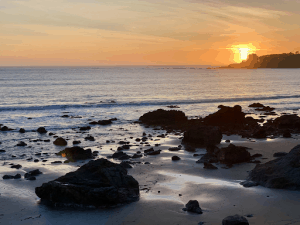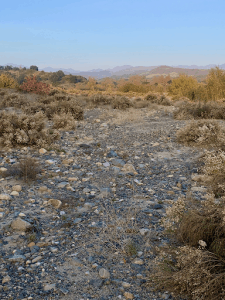January in the Natural Garden
- Posted in: Blog, Monthly Garden Advice
- Tags Seasonal Gardening

Happy New Year! That’s the word looking at the calendar anyway. In the natural garden we celebrate New Year’s on September 1 as the start of a new growing season for native plants. All the same, by convention we’ll celebrate the first of 2021. So far it’s looking like the last of 2020, clear and dry. That’s OK. If we stay dry through spring, our native plants will show us their mettle this summer.
Current events, history, review, and notes
What a difference a year makes. It’s too early to call it a “dry year,” but precious winter days are slipping by warm and waterless. By January 1 last year we had received 7.5” of rain and by comparison, this year we’ve had only 2”. Our long term forecast shows no rain in sight for the first 3 weeks of January. We who work with native plants do not find these facts worrisome because our plants can take it, but still, we love normal rain. It makes for less stress on our natural ecosystems and it more clearly accents the seasonal aspects of our gardens.
Watering
In our last newsletter, December 2020 Watering we explained how water enters, moves, and is stored in the soil, and how plants use it. Suffice it to say rainwater is better than hose water, so keep praying for rain. We got about 1.3” just before year’s end, which probably soaked to a depth of about 10”. In winter our plants do not use much water for cooling and growing, and especially with natives, the nighttime dew does wonders in keeping a dry landscape looking good. Still, the root zone will need water in a few months.
Your soil should have a healthy level of moisture and now your job is to keep it moist until the next rain. If somehow your soil happens to still dry and your plants are not suffering, it is because native plants are adapted to just about any condition nature can throw at them.
Since we like to “garden ahead” we want to assure uniform moisture to a depth of 2-3+ feet when spring arrives in late March. We need to water accordingly during these extended wet-season dry spells. When (if) the rains come, we’ll hold back on watering and reach the same goal.

Related to Watering
An easy way to achieve a Deep Soak September 2020 Related to Watering in a winter dry garden would be to use a hose end mini-sprinkler with the hose barely on, watering a spot here, then a spot there, and moving the sprinkler around. Assuming the sprinkler is watering an area around 3-5’ diameter, it is delivering very little water and can be left in one place for 24+ hours. Absent the mini-sprinkler, you can do the same with the hose set at a trickle. The advantage of the sprinkler is that it spreads the water out a little better.
Pruning
Cut Matilija poppy to the ground leaving only stem 4-6” high. New shoots will emerge from the ground. Any other pruning you do in January is done because you didn’t get around to it in October/November. See October 2020 Pruning for complete detail. If you have deciduous fruit trees (i.e.; peach, pear, cherry, plum, etc.) this is the month to prune them and if you want to become an expert at this, you’ll need lots of practice. Check out the 1944 classic (available as a 2015 Google book), “How to Prune Fruit Trees,” by southern California’s own R. Sanford Martin. Also, January is time to prune dormant rose bushes, a most basic garden task.
Weeding
Mid-winter weed control is easy since the weeds are just starting to germinate. Sometimes an inch or two of mulch will smother them and deprive them of light. By hoeing them out, you get them while they’re small and work the biceps and abs at the same time. You can also use a 3-prong cultivator to break up the soil crust. No chemical herbicide sprays please.
Mulching/Top dress
The best top dress is the “leaf litter” that accumulates directly under the canopy of native plants as they lose and replace leaves over time. Importing “mulch” can be risky business, as when you spread any foreign material onto the soil surface in your garden you will have to live with the positive and/or negative effects of this action for a long time. If you bring in alien mulch, use only clean material, preferably of a known source or from a reputable provider. Late fall and late spring are the best times to do this, so it is not recommended for January unless your soil is bare and you need to top dress now. More information is available here November 2020 Mulching/Top dress. Consider shredding the fallen leaves from neighborhood trees such as sycamore or liquidambar to make a light, flaky top dress.
Feeding
It’s too cold to feed with any effect or result. More on this in March.
Troubleshooting – Varmints, Pests and Diseases
Most of the garden pests are taking a rest along with your entire garden. As always, try to get control over Argentine ants, because they harbor and protect a few bad guys like aphid, scale and mealybug. If you see big holes in plants’ leaves, try to determine if they were caused by insects with rasping mouthparts, (mollusks – snails, slugs), or chewing mouthparts (grasshoppers, caterpillars, beetles). Mollusks leave slime trails. The others leave frass. Frass is caterpillar poop. It is digested leaves that look like uniformly shaped granules of dirt.
Annual Wildflowers
For sure this year, January is not too late to sow wildflower seeds. It looks like we’ll have a late spring. Regardless, germination has been delayed by lack of rain so get that seed sown as soon as possible. Stop by. We have several pre-blended mixes. November 2020 Annual Wildflowers .
Adding New Plants

The January winter garden is a perfect place for you to slow down because all nature is taking a rest. Focus on your open ground and visualize new plants this spring, growing fast and filling in. Come on over, we have a nice selection. Any winter day is a perfect day to add new plants to your garden. Add several. Take your time. Dig holes and work at a winter’s day pace, stopping to watch and listen to the birds, pulling a couple weeds or trimming a few branches. Enjoy the process. Water your new plants in, and then sit back to absorb the fruits of your activity.
Engage
We have more hours of dark than light this season. Is your garden delightful at night? Plant a few plants with grey, silver, or white leaves. Place a few white rocks, or better yet, white quartz pegmatite, granite, or for that matter any white crystalline stone along the path or at key junctions. If you have a pond, do you have a few white crystals in it, or near it, for nighttime viewing? Think about night blooming plants like evening primrose. Clusters of fairy-lantern-like white flowers on manzanita seem to glow on nights when the moon is big. A chalk dudleya looks as if a star fell and got tucked in among boulders, and white leaved buckwheat species will suggest patches or mounds of snow. When the sun comes out, and everything goes back to “normal,” you might wonder if your experience in the winter’s night garden was a dream.
Let’s make 2021 the best year ever!
Not only are we gonna make it, we’re already makin’ it!
From the January Garden,
Mike Evans
Questions? Help is just one call or one email away. Call (949) 728-0685 or email (with pictures if you like) our special helpline: gardenhelp@californianativeplants.com